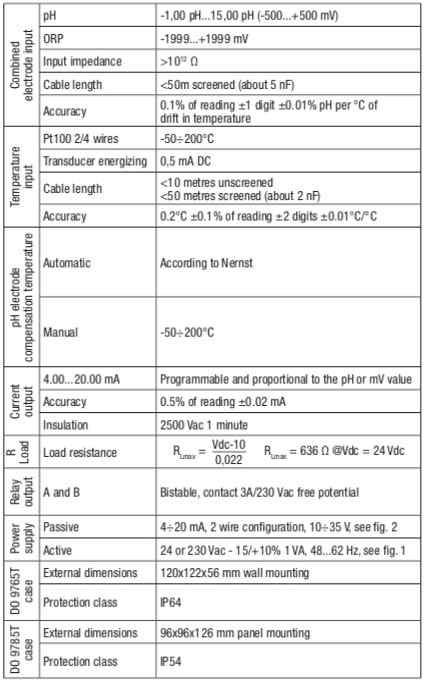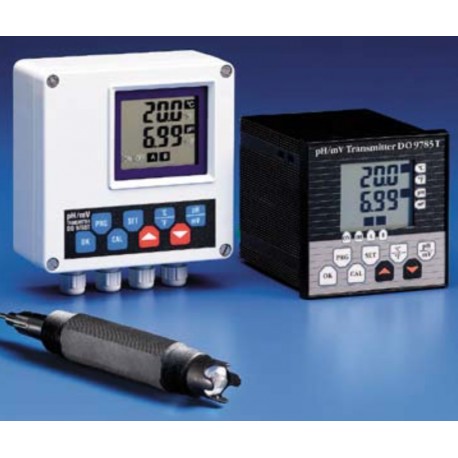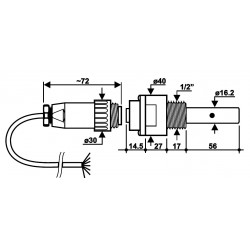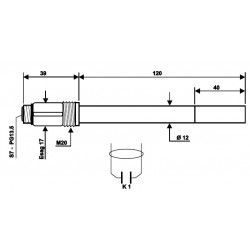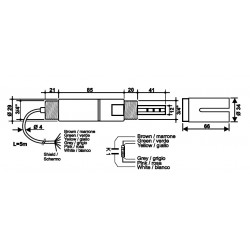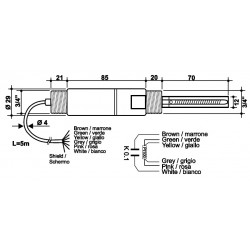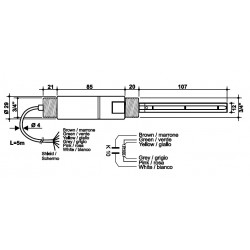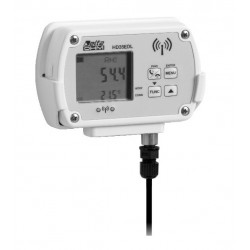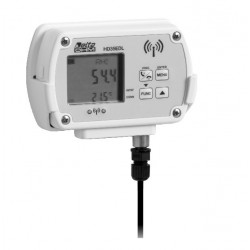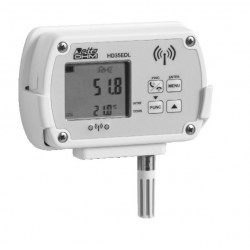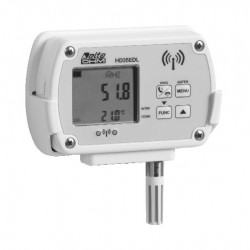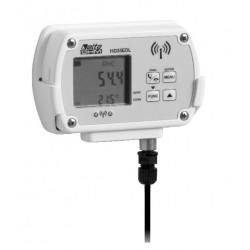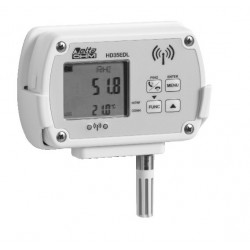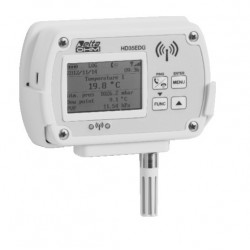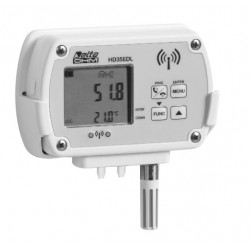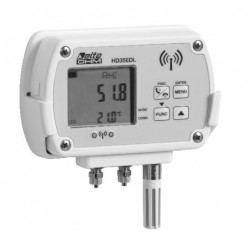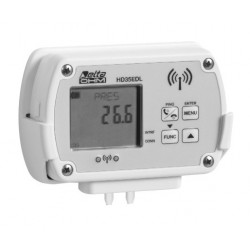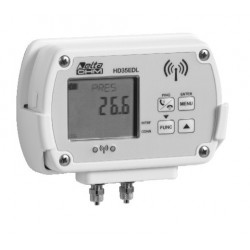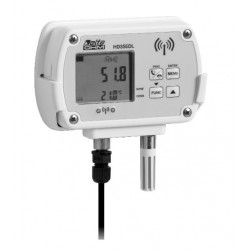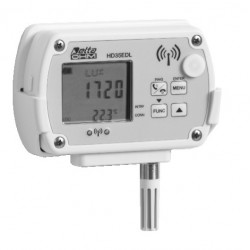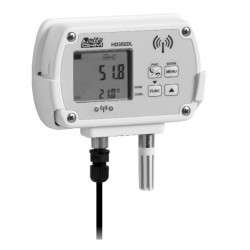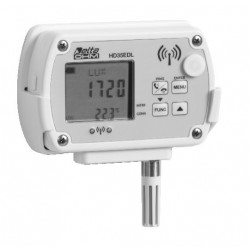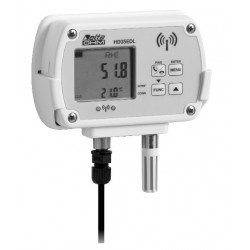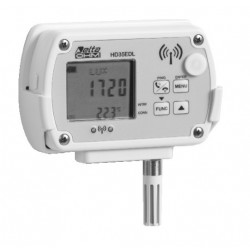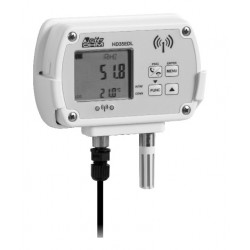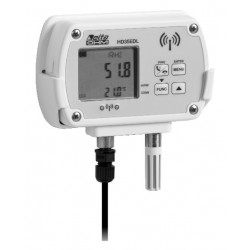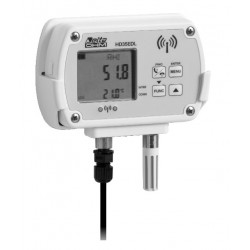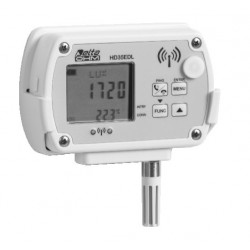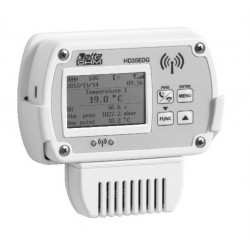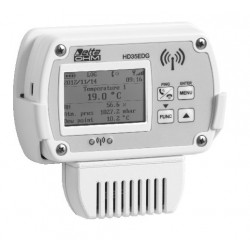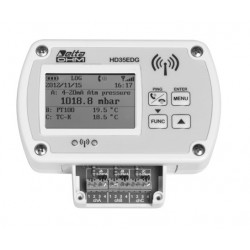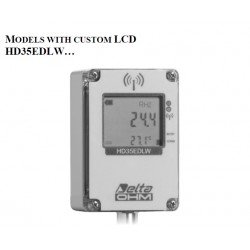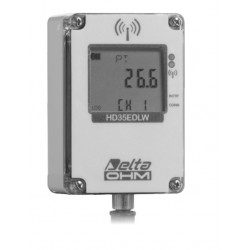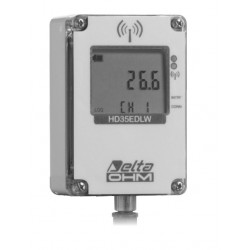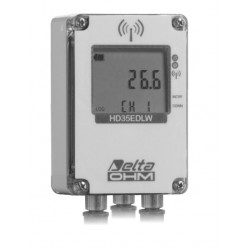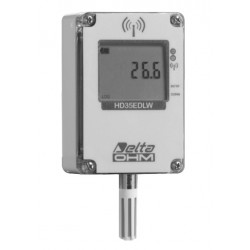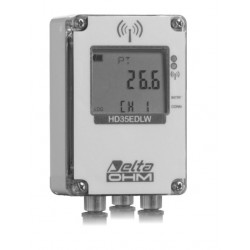No products
Prices are tax excluded
Product successfully added to your shopping cart
There are 0 items in your cart. There is 1 item in your cart.
DO9785T/DO9765T pH or mV Transmitters
DO9785T/DO9765T
New
DO9785T/DO9765T pH transmitters convert the output of a pH electrode, with temperature compensation, into a 4÷20 mA signal. The pH electrode input circuit is galvanically insulated against the 4÷20 mA output signal.
An LCD indicator allows viewing of the process signal value and of the various parameters. The accurate design and choice of components make the instrument precise and reliable for a long working life.
The instrument works with a pH electrode or Redox and a temperature probe (Pt 100 sensor, 100 Ω at 0°C).
- Consulta este producto
- Remove this product from my favorite's list.
- Add this product to my list of favorites.
| The Sensor measures: | pH |
- Key functions:
PRG:
Programming of the parameters is activated by pressing the PRG key plus the
▲ and ▼ keys. The message P1 appears on the display, indicating that the parameter P1 is being programmed. When the PRG key is pressed continuously, the messages P2, P3, P4, P5, P6, P7 and the corresponding parameters are displayed in sequence. After P7 the instrument returns to normal function.
SET:
Key for setting the relay intervention threshold. The ON or OFF symbol appears on the display, indicating the switching on or off threshold of relay A or of relay B.
°C/°F:
- If this key is pressed it changes the temperature measuring unit to degrees Celsius or degrees Fahrenheit.
- When pressed together with the CAL key it activates the manual temperature setting function.
- If pressed during the conductivity calibration function it quits the calibration function without storing the calibration.
pH/mV:
- If this key is pressed it changes the measuring unit to mV or pH.
- When pressed together with the CAL key it activates the pH calibration function
OK:
Confirms the programming parameters, or the relay SET values, and stores them
CAL:
- When pressed together with the °C/°F key it activates the manual temperature setting function.
- When pressed together with the pH/mV key it activates the pH calibration function.
- Key used to confirm pH calibration and manual temperature calibration
▲
- Key for increasing the value displayed in the parameter programming phase.
- During the relay SET point programming phase.
- During the calibration phase.
▼
- Key for decreasing the value displayed in the parameter programming phase.
- During the relay SET point programming phase.
- During the calibration phase.
- Setting the relay SET point:
- Press the SET button; the ON symbol appears on the display with the letter A to indicate that the value shown corresponds to the switching on threshold of relay A.
- To change this value press the ▲ and ▼keys.
- Press SET; the OFF symbol appears with the letter A to indicate that the switching off threshold of relay A is being displayed.
- To change this value press the▲ and ▼keys.
- Press the SET button; the ON symbol appears on the display with the letter B to indicate that the value shown corresponds to the switching on threshold of relay B.
- To change this value press the ▲ and ▼keys
- Press SET; the OFF symbol appears with the letter B to indicate that the switching off threshold of relay B is being displayed.
- To change this value press the ▲ and ▼keys
- Press SET, the instrument stores the values and returns to normal function.
NOTE: During the SET point setting phase (symbols ON or OFF lit) the instrument returns to normal function if no key is pressed for 2 minutes.
- Temperature setting for manual compensation:
If the temperature probe is not connected or if the probe is broken the measuring unit °C or °F flashes. In this case it is possible to set the temperature compensation value manually.
- Press the CAL key and the °C/°F key together; the message CAL appears at the bottom of the display.
- Using the ▲ and ▼keys, set the temperature value corresponding to the temperature of the liquid in which you wish to measure the pH value.
- Press CAL to confirm this value. The message CAL disappears.
- Calibration of the DO9785T/DO9765T with pH electrode
Calibration of the offset of the pH electrode:
- Immerse the electrode in the buffer solution used for calibrating the offset (6.86 pH).
- Press the CAL key and the pH/mV key together; the message CAL appears at the top of the display.
- Using the ▲ and ▼keys, adjust the pH value measured as a function of the liquid temperature.
- Press CAL to confirm this value. The message CAL disappears.
Calibration of the slope of the pH electrode:
- Immerse the electrode in the buffer solution used for calibrating the slope (4.01 or 9.18 pH).
- Press the CAL key and the pH/mV key together; the message CAL appears at the top of the display.
- Using the ▲ and ▼keys, adjust the pH value measured as a function of the liquid temperature.
- Press CAL to confirm this value. The message CAL disappears.
NOTE: If you want to quit without storing the new calibration, press the °C/°F key.
N.B.: The instrument can automatically recognize three standard calibration solutions: 4.01 pH, 6.86 pH and 9.18 pH.
- Programming the parameters:
P1 Relay control unit and analog output, pH or mV.
P2 pH/mV value corresponding to 4 mA at output. May be set between -1.00 pH and 15.00 pH or between -1999 mV and +1999 mV.
P3 pH/mV value corresponding to 20 mA at output.. May be set between -1.00 pH and 15.00 pH or between -1999 mV and +1999 mV.
P4 Delay time in the intervention of relay A. May be set between 0 and 255 seconds.
P5 Delay time in the intervention of relay B. May be set between 0 and 255 seconds.
P6 Calibration of Pt100 probe, calibration of output in current, calibration of output in voltage. (Calibration procedure to be carried out at a laboratory by skilled personnel).
P7 Display of the offset voltage value and of the slope value of the electrode.
To change one of these parameters press key PRG until the message corresponding to the parameter to be changed appears on the screen. Using the ▲ and ▼ keys, bring the parameter displayed to the desired value. Press OK to confirm.
Parameter P7 cannot be altered.
- Calibrating the voltage input (calibration procedure to be carried out at a laboratory by skilled workers):
- Press the PRG key until the message P6 appears on the display.
- Press the CAL key four times; the message CAL appears at the top of the display and the mV value of the input at the bottom.
- Simulate a voltage of 0 mV at the input (if the value is between ±25 mV the zero is calibrated, otherwise the full scale value is calibrated).
- Using the ▲ and ▼ keys, adjust the voltage value so as to have the correct voltage value on the display.
- Press the SET button, the ON symbol appears on the display to indicate that
the instruments is measuring the voltage of the input using the second scale of
measurement.
- Using the ▲ and ▼ keys adjust the voltage value so as to have the correct voltage value on the display.
- Press the set button, on the display the symbol ON disappears
- Simulate a voltage of 450 mV at the input, corresponding to the full value of the first scale.
- Using the ▲ and ▼ keys, adjust the voltage value so as to have the correct voltage value on the display.
- Simulate a voltage of 1800 mV at the input, corresponding to the full value of the second scale.
- Using the▲ and ▼ keys, adjust the voltage value so as to have the correct voltage value on the display.
- Press OK to confirm.
- Pt100 probe calibration (100 Ω at 0°C) (calibration procedure to be carried out at a laboratory by skilled workers):
- Connect the Pt100 probe to the instrument. Press the PRG key until the message P6 appears on the display.
- Press the CAL key; the message CAL appears at the bottom of the display and the temperature is shown at the top.
- Immerse the Pt100 probe and a precision thermometer for reference in the zero calibration bath. Wait long enough for the reading to become stable.
- Using the ▲ and ▼ keys, adjust the value of the temperature measured by the Pt100 probe so that it corresponds with the value on the reference thermometer.
- Immerse the Pt100 probe and a precision thermometer in the full scale calibration bath. Wait long enough for the reading to become stable.
- Using the ▲ and ▼ keys, adjust the value of the temperature measured by the Pt100 probe so that it corresponds with the value on the reference thermometer.
- Press OK to confirm.
N.B.: If the temperature shown by the instrument is between ±12°C, the instrument calibrates the probe offset, otherwise it calibrates the gain.
- Calibrating the analog output (calibration procedure to be carried out at a laboratory by skilled workers):
- Press the PRG key until the message P6 appears on the display.
- Connect a precision milliammeter to the analog output.
- Press the CAL key twice; the message CAL appears at the top of the display and the message 4.0 at the bottom, indicating calibration at 4 mA.
- Using the ▲ and ▼keys, adjust the value of the output current so as to have an indication of 4.0 mA on the precision milliammeter.
- Press the CAL key; the message CAL appears at the top of the display and the message 20.0 at the bottom, indicating calibration at 20 mA.
- Using the ▲ and ▼ keys, adjust the value of the output current so as to have an indication of 20.0 mA on the precision milliammeter.
- Press OK to confirm.
- Display:
Symbol description
°C the value shown is in °C.
°F the value shown is in °F.
pH the unit of the value shown is pH.
mV the unit of the value shown is milli Volts.
A the relay A is in closed status.
B the relay B is in closed status.
ON the value shown corresponds to the closing thresholds of the contacts of
relay A or B.
OFF the value shown corresponds to the opening thresholds of the contacts of
relay A or B
- Error signal:
OFL - Warning which appears during measurement when the value to be displayed is out of scale.
E1 - Error warning which appears during pH calibration to indicate that the offset
value of the electrode is too high in absolute value.
E2 - Error warning which appears during pH calibration to indicate that the difference between the mV readings given by the two buffer solutions used for calibration is too great.
E3 - Error warning which appears during pH calibration to indicate that the mV
readings given by the two buffer solutions used for calibration are too close
(about 50 mV at 25°C).
E4 - Reading error on the EEPROM.
E5 - Error warning indicating that the slope calculation gives a value 20% lower than the nominal value or gives a negative value.
E6 - Error warning indicating that the slope calculation gives a value 150% higher than the nominal value.
- Order code:
DO9785T: pH transmitter 4÷20 mA passive or active, power supply 24 Vac with double display 96x96 mm, for panel mounting.
DO9765T: pH transmitter 4÷20 mA passive or active, power supply 24 Vac with double display 122x120, for use on the field.
HD882 M100/300: Temperature probe with Pt100 sensor, miniature head, shaft Ø6x300 mm.
HD882 M100/600: Temperature probe with Pt100 sensor, miniature head, shaft Ø6x600 mm.
HD8642: Buffer solution 4.01 pH.
HD8672: Buffer solution 6.86 pH.
HD8692: Buffer solution 9.18 pH.
HDR220: Buffer solution Redox 220 mV 0,5l. HD R468: Buffer solution Redox 468 mV 0,5l.
HD62PT: Diaphragm cleaning (tiourea in HCl) - 500ml.
HD62PP: Protein cleaning (pepsin in HCl) - 500ml.
HD62RF: Regeneration (fluorhydric acid) - 100ml.
HD62SC: Solution for electrode preservation - 200ml.
CP5: Extension cable 5m. Connector BNC/S7.
CP10: Extension cable 10m. Connector BNC/S7.
CP15: Extension cable 15m. Connector BNC/S7.
CP5T: Extension cable 5m. Connector S7/wire.
CP5/10T: Extension cable 10m. Connector S7/wire.
KPI10: Combined industrial electrode, S7 PG13.5 connector, gel, glass body, Ag/AgCl sat KCl Ø12x120 mm, temperature 0÷130°C, porous Teflon fitting.
KPI11: Combined industrial electrode, S7 brass 3/4” connector, Rytron body, Ag/AgCl sat KCl, temperature 0÷100°C, porous Teflon fitting.
KPI12: Platinum electrode for Redox measurement,S7 PG13,5 connector, Ag/AgCl sat KCl, temperature 0÷130°C, pressure 6 bar.
KPI13: Platinum electrode for Redox measurement, Rytron body, S7 PG13,5 connector, temperature 0÷100°C, Ag/AgCl sat Kcl.
Panel mounting pH or mV completely configurable.
96x96 mm with dual LCD (measurement + temperature).
Output 4...20mA insulated with 2 wires passive or with 4 wires active.
Power supply in active mode 24Vac, on request 230Vac, in passive mode 10...35Vdc.
